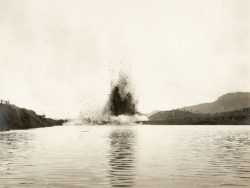The Gamboa Dike

On 10th October 1913, U.S. President Woodrow Wilson, triggered the explosion of the Gamboa Dike that ended the construction of the Panama Canal.
Men had dreamed of it for centuries - the passageway from the Gulf of Panama to the Caribbean Sea, and over the centuries, leaders and adventurers toyed with the idea.
The dream had lived in the United States even more so. Everybody agreed that such a canal was necessary to U.S. defense, as well as a good thing for trade. In 1904, under President Theodore Roosevelt, arrangements were completed - and as those who worked on the canal put it, the dirt began to fly!
But living the dream wasn't so easy, with the digging of a vast 50 mile-long trench through thick, disease-ridden jungle in fever-ridden Panama resulting in an estimated 5600 deaths from disease and accidents during the U.S. construction phase of the canal alone.
That said, it is one of the largest and most difficult engineering projects ever undertaken, creating a shortcut which has continued to greatly reduce the time for ships to travel between the Atlantic and Pacific Oceans, enabling them to avoid the lengthy and particularly hazardous Cape Horn route around the southernmost tip of South America via the Drake Passage or Strait of Magellan.
On May 20th 1913 two battered steam shovels met at the bottom of the Culebra Cut and sounded their horns - the digging was over. The explosion of the Gamboa Dike on 10th October 1913 succeeded in flooding the final stretch of dry passageway at Culebra Cut, and the Panama Canal officially opened on August 15, 1914.
Because of its significance at the time, there were several dramas written to document its incredible success, and these were adapted for radio, which you can listen to on RUSC.
Science Magazine of the Air - She-Devil
Inheritance - Gorgas and the Panama Canal
Cavalcade of America - Colossus of Panama
Cavalcade of America - Yellow Jack
They're all exciting tales of the determination and success of the people who worked on the Panama Canal, and Joy and I really hope that you'll enjoy listening to them as much as we did.
Happy listening my friends,
